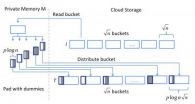(Press-News.org) Stars forming like a string of blue pearls along two elliptical galaxies could be the result of a galactic merger, according to an international team of astronomers. The structure could reveal rare insights about elliptical galaxies.
Scientists from Rochester Institute of Technology helped analyze data from the Hubble Space Telescope showing elliptical galaxies coalescing at the core of a dense galaxy cluster. The study is part of a program sponsored by the Hubble Space Telescope—an international cooperation between NASA and the European Space Agency—to look inside 23 massive clusters first catalogued in the Sloan Digital Sky Survey.
Findings of the study, "A thirty-kiloparsec chain of 'beads-on-a-string' star formation between two merging early type galaxies in the core of a strong-lensing galaxy cluster," are available online, at http://arxiv.org/abs/1407.2251 and in an upcoming issue of The Astrophysical Journal Letters.
"These data were originally taken for a completely different purpose—to study the bluish arcs on larger scales in the cluster," said Chris O'Dea, professor in RIT's School of Physics and Astronomy and a co-author on the paper. "We were not expecting to catch these two elliptical galaxies in this spectacular burst of star formation."
O'Dea and co-author Stefi Baum, professor and director of RIT's Chester F. Carlson Center for Imaging Science, were thesis advisers and mentors of the paper's lead author, Grant Tremblay, a post-doctoral fellow at the European Southern Observatory in Garching, Germany, and an inaugural alumnus of RIT's astrophysical sciences and technology Ph.D. program. Tremblay will join Yale University as a NASA Einstein Fellow in September.
The 100,000-light-year-long structure identified in the Hubble data is dotted with 19 young, blue star clusters like pearls on a string, evenly spaced and separated by 3,000 light-years. The star necklace will lose its shape in about 10 million years as each of the 19 stellar superclusters follows a different orbit, Tremblay said.
Earlier observations of star clusters forming in evenly distributed clumps in spiral galaxies could explain Tremblay's "serendipitous discovery" in the Hubble data.
"This phenomenon has never been seen before in merging elliptical galaxies," Tremblay said. "We have two big monsters and they're playing tug-of-war with this necklace."
Tremblay and his team suggest three possible scenarios that could have created the string-of-pearl stars between two elliptical galaxies:
Merger—Coalescing galaxies triggered a reservoir of cold gas into star formation
Cooling flow of gas—Hot gas from the X-ray atmosphere around the galaxies cooled into puddles of cold molecular gas and started to form stars
Collision—A galactic collision created an X-ray shock catalyzing the star formation by compressing the gas and cooling the plasma.
"Compared to a galaxy's lifetime of billions of years, star formation processes—which take millions of years—are quite brief," said Kevin Cooke, graduate student in RIT's astrophysical sciences and technology program. "To find such an event in early type galaxies where star formation is rare is an incredibly fortunate find. Research into star formation in galaxies helps address many fundamental questions about the universe, and this rare star formation event will help propel this field of knowledge."
INFORMATION:
Tremblay's team has a strong connection to his alma mater, RIT, with three co-authors from the university—Baum, O'Dea and Cooke. In addition to the RIT contingent, the team of scientists includes Michael Gladders, University of Chicago; Matthew Bayliss, Harvard University and Harvard-Smithsonian Center for Astrophysics; Håkon Dahle, University of Oslo; Timothy Davis, European Southern Observatory; Michael Florian, University of Chicago; Jane Rigby, NASA Goddard Space Flight Center; Keren Sharon, University of Michigan; Emmaris Soto, the Catholic University of America; and Eva Wuyts, Max-Planck-Institut für extraterrestrische Physik.
Diving for pearls with the Hubble Space Telescope
RIT astronomers help find star 'necklace' connecting elliptical galaxies
2014-07-10
ELSE PRESS RELEASES FROM THIS DATE:
Want a higher GPA in college? Join a gym
2014-07-10
EAST LANSING, Mich. – For those students looking to bump up their grade point averages during college, the answer may not be spending more time in a library or study hall, but in a gym.
New Michigan State University research shows that students who were members of the recreational sports and fitness centers on MSU's campus during their freshman and sophomore years had higher GPAs than those who weren't.
The research also indicated that students with memberships stayed in school longer. An increase of 3.5 percent in two-year retention rates was seen among this group.
"That ...
Feedback control could be key to robust conservation management
2014-07-10
Mathematical algorithms used to control everyday household items such as washing machines could hold the key to winning the fight for conservation, a new study has claimed.
As part of an EPSRC research project, a team of UK scientists and mathematicians, including those from the University of Exeter, have shown how techniques commonly used in control engineering, could be replicated in the natural world to help restock declining populations.
The innovative new study suggests 'integral control' - in essence a built-in feedback control mechanism to maintain a constant – ...
Wildfires dot central Russia's landscape
2014-07-10
This natural-color satellite image was collected by the Moderate Resolution Imaging Spectroradiometer (MODIS) aboard the Aqua satellite on July 10, 2014. Each hot spot, which appears as a red mark, is an area where the thermal detectors on the MODIS instrument recognized temperatures higher than background. When accompanied by plumes of smoke, as in this image, such hot spots are diagnostic for fire.
This area of Russia is extremely remote with little danger coming directly from the fires, although the smoke released by any type of fire (forest, brush, crop, structure, ...
Ferromagnetism at 230 K found in a new diluted magnetic semiconductor by Chinese physicists
2014-07-10
Diluted magnetic semiconductors (DMS) have received much attention due to their potential application in spintronics, or the storage and transfer of information by using an electron's spin state, its magnetic moment and its charge.
In typical systems based on III-V semiconductors, such as (Ga,Mn)As, (In,Mn)As or (Ga,Mn)N, substitution of divalent Mn atoms into trivalent Ga (or In) sites leads to severely limited chemical solubility, resulting in metastable specimens only available as epitaxial thin films. The hetero-valence substitution, which simultaneously dopes both ...
Scientists discover clues why weight-loss surgery cures diabetes
2014-07-10
Scientists at The University of Manchester are a step closer to understanding why diabetes is cured in the majority of patients that undergo gastric bypass surgery.
The research, published in the journal Endocrinology, shows the cure is likely to be explained by the actions of specialised cells in the intestine that secrete a cocktail of powerful hormones when we eat.
During the research, the team showed that gut hormone cells previously thought to contain just one hormone, had up to six hormones including the hunger hormone ghrelin.
Study team leader, Dr Craig ...
Straits of Mackinac 'worst possible place' for a Great Lakes oil spill
2014-07-10
ANN ARBOR – Because the strong currents in the Straits of Mackinac reverse direction every few days, a rupture of the oil pipeline beneath the channel would quickly contaminate shorelines miles away in both lakes Michigan and Huron, according to a new University of Michigan study commissioned by the National Wildlife Federation.
In one scenario examined in the study and accompanying animations, oil from a hypothetical pipeline break reached Mackinac Island and Round Island after 12 hours and Bois Blanc Island after two days. All three islands are in westernmost Lake Huron, ...
New drug active against most aggressive type of lung cancer cells
2014-07-10
Manchester scientists have shown that a new drug could prove useful in treating small cell lung cancer - the most aggressive form of lung cancer.
Scientists from the Cancer Research UK Manchester Institute, based at The University of Manchester and part of the Manchester Cancer Research Centre, teamed up with experts at AstraZeneca, as part of a collaboration agreed in 2010, to test a drug – known as AZD3965 - on small cell lung cancer cells.
The research, published in the journal Clinical Cancer Research, also helps identify which patients are most likely to respond ...
New therapeutic combination to slow resistant sarcomas
2014-07-10
Researchers at sarcomas research group at the Bellvitge Biomedical Research Institute (IDIBELL) and the Catalan Institute of Oncology (ICO) have been tested in 19 patients a new therapeutic combination to combat resistant sarcomas. The clinical trial results, which indicate that the new treatment could stabilize the growth of these tumors have been published this week in the British Journal of Cancer.
Sarcomas
Sarcomas are a rare type of tumor and complex since there are several subtypes. It can affect from children to older ages. It is usually diagnosed in advanced and ...
'Melbourne Shuffle' secures data in the cloud
2014-07-10
PROVIDENCE, R.I. [Brown University] — To keep data safe in the cloud, a group of computer scientists suggests doing the Melbourne Shuffle.
That may sound like a dance move (and it is), but it's also a computer algorithm developed by researchers at Brown University.
The computing version of the Melbourne Shuffle aims to hide patterns that may emerge as users access data on cloud servers. Patterns of access could provide important information about a dataset — information that users don't necessarily want others to know — even if the data files themselves are encrypted.
"Encrypting ...
The bigger the better: Cigarette warning labels prompt quit attempts
2014-07-10
WASHINGTON - Cigarette warning labels can influence a smoker to try to quit even when the smoker is trying to avoid seeing the labels, according to a survey of thousands of adult smokers in four countries published by the American Psychological Association.
Small, text-only warning labels like those on cigarette packs in the United States prompt people to think about health risks of smoking, and people who notice the warnings regularly are more likely to try to quit, the research found. Larger, more graphic warning labels like those in other countries, such as Australia, ...
LAST 30 PRESS RELEASES:
Injectable breast ‘implant’ offers alternative to traditional surgeries
Neuroscientists devise formulas to measure multilingualism
New prostate cancer trial seeks to reduce toxicity without sacrificing efficacy
Geometry shapes life
A CRISPR screen reveals many previously unrecognized genes required for brain development and a new neurodevelopmental disorder
Hot flush treatment has anti-breast cancer activity, study finds
Securing AI systems against growing cybersecurity threats
Longest observation of an active solar region
Why nail-biting, procrastination and other self-sabotaging behaviors are rooted in survival instincts
Regional variations in mechanical properties of porcine leptomeninges
Artificial empathy in therapy and healthcare: advancements in interpersonal interaction technologies
Why some brains switch gears more efficiently than others
UVA’s Jundong Li wins ICDM’S 2025 Tao Li Award for data mining, machine learning
UVA’s low-power, high-performance computer power player Mircea Stan earns National Academy of Inventors fellowship
Not playing by the rules: USU researcher explores filamentous algae dynamics in rivers
Do our body clocks influence our risk of dementia?
Anthropologists offer new evidence of bipedalism in long-debated fossil discovery
Safer receipt paper from wood
Dosage-sensitive genes suggest no whole-genome duplications in ancestral angiosperm
First ancient human herpesvirus genomes document their deep history with humans
Why Some Bacteria Survive Antibiotics and How to Stop Them - New study reveals that bacteria can survive antibiotic treatment through two fundamentally different “shutdown modes”
UCLA study links scar healing to dangerous placenta condition
CHANGE-seq-BE finds off-target changes in the genome from base editors
The Journal of Nuclear Medicine Ahead-of-Print Tip Sheet: January 2, 2026
Delayed or absent first dose of measles, mumps, and rubella vaccination
Trends in US preterm birth rates by household income and race and ethnicity
Study identifies potential biomarker linked to progression and brain inflammation in multiple sclerosis
Many mothers in Norway do not show up for postnatal check-ups
Researchers want to find out why quick clay is so unstable
Superradiant spins show teamwork at the quantum scale
[Press-News.org] Diving for pearls with the Hubble Space TelescopeRIT astronomers help find star 'necklace' connecting elliptical galaxies




